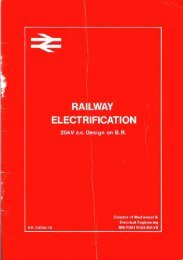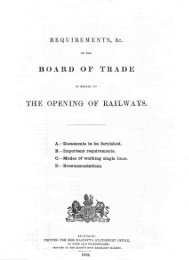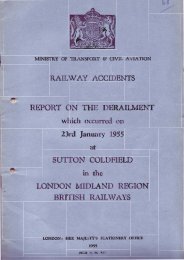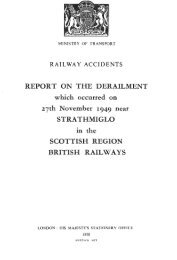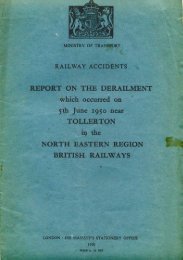- Page 1 and 2: R A I LT R AC K 1 9 9 9 N E T WOR K
- Page 3 and 4: 1 introduction Page 12 1.1 Introduc
- Page 5: 4 foreword The 12 months since publ
- Page 10 and 11: What the plans deliver The major de
- Page 12 and 13: Progress since the 1998 NMS The tim
- Page 14 and 15: In this section, we set out the str
- Page 16 and 17: 1.4 1.4 Context The periodic review
- Page 18 and 19: We firmly believe that risk is best
- Page 20 and 21: Integrated transport In the past 12
- Page 22 and 23: The Network Management Statement is
- Page 24 and 25: 2.2 2.2 Consultation with our custo
- Page 26 and 27: Of those who were satisfied,the mos
- Page 28 and 29: We report on the substantial progre
- Page 30 and 31: 3.5 3.6 3.5 Year 2000 compliance an
- Page 32 and 33: Examples of significant work Woking
- Page 34 and 35: In this section, we set out what ne
- Page 36 and 37: 4.2 4.2 Expenditure summary The mai
- Page 38 and 39: 4.4 4.4 Renewals policy We have wor
- Page 40 and 41: ecomes due for total renewal at the
- Page 42 and 43: Continued improvement. The completi
- Page 44 and 45: on the network.These safety improve
- Page 46 and 47: Environmental commitments First, ov
- Page 48 and 49: This section describes the impact o
- Page 50 and 51: Table A Delays to train services RA
- Page 52 and 53: Accessibility Category A Category B
- Page 54 and 55: Table F Asset condition SPEED RESTR
- Page 56 and 57: 5.4 5.4 Network utilisation Capacit
- Page 58 and 59:
Loading gauge This stipulates the m
- Page 60 and 61:
Electrification 38% of the rail net
- Page 62 and 63:
This section sets out our ambitious
- Page 64 and 65:
H e a t h r ow Express commenced se
- Page 66 and 67:
een discussed with customers,funder
- Page 68 and 69:
SUMMARIES OF KEYLOCATIONS IDENTIFIE
- Page 70 and 71:
6.6 6.6 Stations and depots Discuss
- Page 72 and 73:
Major stations Last year, we report
- Page 74 and 75:
6.8 6.9 6.8 Timetabling With an inc
- Page 76 and 77:
Table A Enhancement expenditure (£
- Page 78 and 79:
Enhancement schemes Previous commit
- Page 80 and 81:
NAME ANDDESCRIPTION OF SCHEME Paddi
- Page 82 and 83:
NAME ANDDESCRIPTION OF SCHEME Victo
- Page 84 and 85:
This section describes our plans fo
- Page 86 and 87:
7.3 Table A Review of customer requ
- Page 88 and 89:
• the impact of these flows on se
- Page 90 and 91:
Proposed gauge enhancements W10 gau
- Page 92 and 93:
Table C Loading gauge classificatio
- Page 94 and 95:
Table G Freight volume, income and
- Page 96 and 97:
Table H Summary of freight specific
- Page 98 and 99:
In this section, we show in more de
- Page 100 and 101:
B How Railtrack could get traveller
- Page 102 and 103:
8.4 We have suggested to the Govern
- Page 104 and 105:
8.5 Thameslink 2000 The primary obj
- Page 106 and 107:
Further developments include: • s
- Page 108 and 109:
This section provides a summary of
- Page 110 and 111:
9.2 9.3 9.2 The Parliament and loca
- Page 112 and 113:
S t a t i o n s . We have committed
- Page 114 and 115:
Key de velopments The map identifie
- Page 116 and 117:
This section gives, for the first t
- Page 118 and 119:
10.3 10.3 Sustaining the network Si
- Page 120 and 121:
We will raise linespeed between Lon
- Page 122 and 123:
Table A Expenditure on maintenance,
- Page 124 and 125:
123
- Page 126 and 127:
16 Great Eastern Main Line and bran
- Page 128 and 129:
Colour coding used on the Route Str
- Page 130 and 131:
Maintenance expenditure (£M - 1998
- Page 132 and 133:
Maintenance expenditure (£M - 1998
- Page 134 and 135:
Maintenance expenditure (£M - 1998
- Page 136 and 137:
Maintenance expenditure (£M - 1998
- Page 138 and 139:
Maintenance expenditure (£M - 1998
- Page 140 and 141:
Maintenance expenditure (£M - 1998
- Page 142 and 143:
Maintenance expenditure (£M - 1998
- Page 144 and 145:
A R West Coast Main Line upgrade sc
- Page 146 and 147:
These are the route improvements we
- Page 148 and 149:
These are the route improvements we
- Page 150 and 151:
Renewals expenditure to deliver the
- Page 152 and 153:
Progress on the 1998 NMS WILLESDEN
- Page 154 and 155:
Route characteristics DESCRIPTION T
- Page 156 and 157:
Our ECML upgrade scheme TAKING THIN
- Page 158 and 159:
Renewals expenditure to deliver the
- Page 160 and 161:
Progress on the 1998 NMS SIGNALLING
- Page 162 and 163:
Route characteristics DESCRIPTION T
- Page 164 and 165:
CAPABILITY CHANGES TO ACHIEVE ROUTE
- Page 166 and 167:
Progress on the 1998 NMS RELIABILIT
- Page 168 and 169:
Route characteristics DESCRIPTION T
- Page 170 and 171:
Renewals expenditure to deliver the
- Page 172 and 173:
Route characteristics DESCRIPTION T
- Page 174 and 175:
Renewals expenditure to deliver the
- Page 176 and 177:
6 Channel Tunnel routes SOUTHERN ZO
- Page 178 and 179:
6 178 Channel Tunnel routes continu
- Page 180 and 181:
7 Derby to Bristol and Didcot via B
- Page 182 and 183:
7 182 Derby to Bristol and Didcot v
- Page 184 and 185:
8 North Trans-Pennine: Liverpool to
- Page 186 and 187:
8 186 North Trans-Pennine: Liverpoo
- Page 188 and 189:
8 188 North Trans-Pennine: Liverpoo
- Page 190 and 191:
9 Birmingham and Coventry to Peterb
- Page 192 and 193:
9 192 Birmingham and Coventry to Pe
- Page 194 and 195:
10 Crewe to Newport via Shrewsbury
- Page 196 and 197:
10 Crewe to Newport via Shrewsbury
- Page 198 and 199:
11 Wolverhampton to Chester, Aberys
- Page 200 and 201:
11 Wolverhampton to Chester, Aberys
- Page 202 and 203:
12 Manchester and Crewe to North Wa
- Page 204 and 205:
12 Manchester and Crewe to North Wa
- Page 206 and 207:
13 Manchester to Sheffield and Nort
- Page 208 and 209:
13 Manchester to Sheffield and Nort
- Page 210 and 211:
14 Edinburgh to Glasgow, Glasgow an
- Page 212 and 213:
14 Edinburgh to Glasgow, Glasgow an
- Page 214 and 215:
14 Edinburgh to Glasgow, Glasgow an
- Page 216 and 217:
15 West Anglia Main Line and branch
- Page 218 and 219:
15 West Anglia Main Line and branch
- Page 220 and 221:
16 Great Eastern Main Line and bran
- Page 222 and 223:
16 Great Eastern Main Line and bran
- Page 224 and 225:
17 London, Tilbury and Southend EAS
- Page 226 and 227:
17 London, Tilbury and Southend con
- Page 228 and 229:
18 Chatham Main Line and North Kent
- Page 230 and 231:
18 Chatham Main Line and North Kent
- Page 232 and 233:
19 Brighton Main Line and South Lon
- Page 234 and 235:
19 Brighton Main Line and South Lon
- Page 236 and 237:
19 Brighton Main Line and South Lon
- Page 238 and 239:
20 South Coastal Route: Portsmouth
- Page 240 and 241:
20 South Coastal Route: Portsmouth
- Page 242 and 243:
21 London to Portsmouth and Weymout
- Page 244 and 245:
21 London to Portsmouth and Weymout
- Page 246 and 247:
22 Wessex routes GREAT WESTERN AND
- Page 248 and 249:
22 Wessex routes continued Renewals
- Page 250 and 251:
23 Clapham Junction to Reading and
- Page 252 and 253:
23 Clapham Junction to Reading and
- Page 254 and 255:
24 Isle of Wight: Ryde to Shanklin
- Page 256 and 257:
24 256 Isle of Wight: Ryde to Shank
- Page 258 and 259:
25 Chiltern Lines MIDLANDS ZONE Chi
- Page 260 and 261:
25 Chiltern lines continued These a
- Page 262 and 263:
26 North London Line EAST ANGLIA ZO
- Page 264 and 265:
26 North London Line continued Rene
- Page 266 and 267:
27 Cotswolds GREAT WESTERN ZONE Cen
- Page 268 and 269:
27 Cotswolds continued Renewals exp
- Page 270 and 271:
28 Cardiff Valleys GREAT WESTERN ZO
- Page 272 and 273:
28 Cardiff Valleys continued These
- Page 274 and 275:
29 West Wales GREAT WESTERN ZONE Wa
- Page 276 and 277:
29 West Wales continued Renewals ex
- Page 278 and 279:
30 West Midlands local routes MIDLA
- Page 280 and 281:
30 West Midlands local routes conti
- Page 282 and 283:
31 East Midlands local routes MIDLA
- Page 284 and 285:
31 East Midlands local routes conti
- Page 286 and 287:
32 Merseyside NORTH WEST ZONE FNW;
- Page 288 and 289:
32 Merseyside continued These are t
- Page 290 and 291:
33 Manchester to the coast NORTH WE
- Page 292 and 293:
33 Manchester to the coast continue
- Page 294 and 295:
34 Lancashire NORTH WEST ZONE FNW;
- Page 296 and 297:
34 Lancashire continued These are t
- Page 298 and 299:
35 Cumbria NORTH WEST ZONE FNW; DRS
- Page 300 and 301:
35 Cumbria continued Renewals expen
- Page 302 and 303:
36 Yorkshire LONDON NORTH EASTERN A
- Page 304 and 305:
36 Yorkshire continued These are th
- Page 306 and 307:
37 North East England LONDON NORTH
- Page 308 and 309:
37 North East England continued The
- Page 310 and 311:
38 South West Scotland SCOTLAND ZON
- Page 312 and 313:
38 South West Scotland continued Th
- Page 314 and 315:
39 Strathclyde SCOTLANDZONE GNER; S
- Page 316 and 317:
39 Strathclyde continued CAPABILITY
- Page 318 and 319:
39 Strathclyde continued Progress o
- Page 320 and 321:
Route characteristics DESCRIPTION T
- Page 322 and 323:
Renewals expenditure to deliver the
- Page 324 and 325:
Route characteristics DESCRIPTION T
- Page 326 and 327:
Renewals expenditure to deliver the
- Page 328 and 329:
42 Freight-only routes SOUTHERN ENG
- Page 330 and 331:
43 Freight-only routes MIDLANDS ZON
- Page 332 and 333:
44 Freight-only routes NORTHERN ENG
- Page 334 and 335:
45 Freight-only routes SCOTLAND ZON
- Page 336 and 337:
appendices 11 Appendices and glossa
- Page 338 and 339:
appendices 340 Appendix 1 Extracts
- Page 340 and 341:
appendices Appendix 4 Customer-reas
- Page 342 and 343:
abbreviations and glossary 344 A B
- Page 344 and 345:
abbreviations and glossary 346 H I
- Page 346 and 347:
abbreviations and glossary 348 S T
- Page 348:
1 9 9 9 N E T WORK M A N AG E M E N



